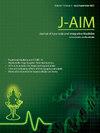Lekhana basi治疗后的尿液外泌体生物标志物-一项试点研究报告
IF 1.7
Q3 INTEGRATIVE & COMPLEMENTARY MEDICINE
引用次数: 0
摘要
背景:肥胖是包括心血管疾病和癌症在内的各种疾病的上升危险因素。目前临床上采用的针对性肥胖治疗方法的局限性强调了开发综合管理策略来识别肥胖的特定生物标志物的重要性。考虑到外泌体/细胞外囊泡(EV)生物标志物的特异性,我们在此旨在鉴定阿育吠陀治疗肥胖的EV生物标志物- Lekhana basi。方法:本研究使用了6名体重指数为bbb30 kg/m2的参与者的18份24小时尿液样本,这些样本是在Lekhana basti(肥胖药物灌肠)治疗期间的3个时间点收集的。采用聚乙二醇(PEG)分离尿液EV。采用1-d凝胶电泳分离,液相色谱-串联质谱(LC-MS/MS)鉴定,无标记法定量。与DisGeNET中的肥胖参考基因相比,鉴定并入围了显著的蛋白质-蛋白质相互作用、KEGG通路分析和富集、功能基因本体(GO)注释。结果:LC-MS/ ms鉴定后,以UniProt为参比,共鉴定出210个外泌体蛋白。通路富集分析中有73个蛋白过表达。此外,GO功能注释鉴定了15种常见的蛋白质。最后,鉴定了8种与肥胖相关的枢纽蛋白,并比较了Lekhana Basti治疗期间三个不同时间点的差异表达谱。肥胖期间过表达的6个蛋白标记物在Lekhana basi治疗后下调,而2个标记物在治疗后丰度增加。结论:据我们所知,这是第一个从印度肥胖女性参与者中分离和鉴定尿EV蛋白丰度的研究。研究结果表明,在Lekhana basi治疗后,与肥胖有关的8个枢纽蛋白的差异表达谱发生了显著变化。试点研究的生物标志物标志表明,阿育吠陀治疗的作用和可能的途径参与治疗肥胖。此外,本研究强调了尿外泌体/EV作为诊断标志物的特异性,以及阿育吠陀治疗在有效管理肥胖方面的潜力。本文章由计算机程序翻译,如有差异,请以英文原文为准。
Urine exosome biomarkers of obesity after Lekhana Basti treatment – Report of a pilot study
Background
Obesity is a rising risk factor for various diseases including cardiovascular diseases and Cancer. The limitations of targeted obesity-treatment approaches employed in the clinic presently underscore the importance of developing integrative management strategies for identification of specific biomarkers of obesity. Objectives: Given the specificity of exosome/extracellular vesicle (EV) biomarkers, we aimed here to identify the EV biomarkers of Ayurveda treatment – Lekhana Basti – for Obesity.
Methodology
A total of eighteen 24-h urine samples from 6 participants with BMI>30 kg/m2 were used in this study, collected over 3 time-points during the Lekhana basti (medicated enema for obesity) treatment. Urine EV were isolated using Polyethylene Glycol (PEG). The proteins were resolved by 1-d gel electrophoresis and identified using liquid chromatography coupled with tandem mass spectrometry (LC-MS/MS) and quantified by label-free methods. Significant Protein-Protein Interactions, KEGG pathway analysis and enrichment, functional gene ontology (GO) annotation were identified and shortlisted in comparison to Obesity reference genes from DisGeNET.
Results
With UniProt as a reference subsequent to LC-MS/MS-identification, a total of 210 exosome proteins were identified. Seventy-three proteins were overexpressed in pathway enrichment analysis. Further, GO functional annotation identified 15 common proteins involved. Finally, the 8 hub proteins associated with obesity were identified and their differential expression profile compared between three different time-points during Lekhana Basti treatment. Six protein markers overexpressed during obesity were downregulated post Lekhana Basti treatment, while 2 markers increased in abundance post-treatment.
Conclusion
To our knowledge, this is the first study to isolate and identify urine EV protein abundance profiles from obese female participants of India. The study results indicate significant changes in the differential expression profile of 8 hub proteins involved in obesity, after Lekhana Basti treatment. The biomarker signature of the pilot study indicates the role of Ayurveda treatment and the possible pathways involved in the treatment of Obesity. Further, this study underlines the specificity of urine exosomes/EV as diagnostic markers as well as the potential of Ayurveda treatment in effective management of obesity.
求助全文
通过发布文献求助,成功后即可免费获取论文全文。
去求助
来源期刊

Journal of Ayurveda and Integrative Medicine
INTEGRATIVE & COMPLEMENTARY MEDICINE-
CiteScore
4.70
自引率
12.50%
发文量
136
审稿时长
30 weeks
 求助内容:
求助内容: 应助结果提醒方式:
应助结果提醒方式:


